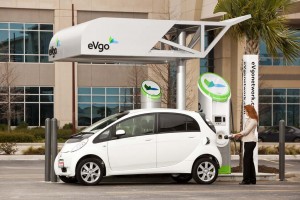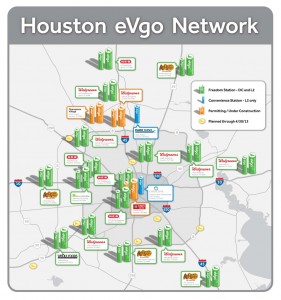While battery sales have been improving in recent months they slowed unexpectedly in November despite the surge in the overall U.S. automotive market. While analysts will likely debate what this specific setback means, even electric vehicle proponents acknowledge sales are being constrained by two key challenges: price and range.
It’s likely to take some time – and some significant developments to lower costs and increase the capacity of today’s lithium-ion battery technology. But a Texas-based start-up is betting it can help overcome the issue of range anxiety by setting up a network of high-speed chargers dubbed “Freedom Stations.”
“We think we can overcome the issue of range anxiety and provide EV owners range confidence,” says Terry O’Day, the director of California Business Development for eVgo.
A new subsidiary of Houston-based power company NRG, eVgo wants to install nearly 400 – and possibly more — high-speed Level III chargers in Texas, California and along the Mid-Atlantic region.
These are significantly more powerful than the so-called “high-speed” chargers that are now being installed at homes, retail or business locations around the country. Using 480-volt direct current allows a battery-car such as the Nissan Leaf or Ford Focus EV to get an 80% “fill-up” in as little as 15 to 20 minutes.
With rare exception, such as the 160 to 300-mile Tesla Model S, most of today’s electric vehicles can manage less than 100 miles between charges. That means that even fully charged, a motorist is setting out with what would be, in a conventional gas vehicle, the fuel gauge closing on “E.” Charging at a conventional home or public charger can take four to eight hours, effectively limiting the functionality of pure battery-electric vehicles.
Proponents believe that Level III charging, if widely available, will make it possible to drive greater distances without constantly worrying about getting to a destination – or back home.
Yet, until this year, there were only a handful of these fast-chargers in the entire country. But that could soon change. Tesla recently announced plans to set up a network of “superchargers” that would provide Level III charging for its products – and for competitors’ vehicles that can use the same plug. eVgo has even bigger ambitions.
It has committed in its first market, Houston, to have 50 stations, 70 in the Dallas-Fort Worth area, 40 in the Mid-Atlantic and 40 in California – to start, with the longer-term goal of setting up as many as 200 in the Golden State, including Freedom Stations at regular distances along California freeways. It has committed $50.5 million to that goal.
When in place, O’Day suggests it will be a “well-distributed network that looks sort of like your cellphone network,” meaning a motorist will be able to travel anywhere within a defined region and know there’ll always be a charger within range.
Each station will have a minimum of one Level III charger – with wiring for more once demand increases – and several slower Level II chargers.
The company also is trying to win over businesses and even apartment landlords to let it set up Level II chargers in their parking lots and garages – for the foreseeable future at no cost. The goal is to have as many as 10,000 spaces wired up in the next few years in cities like Santa Monica –where the majority of residents either live in apartment buildings or condominiums where they might not otherwise have a place to plug in a battery car.
That’s the conundrum, he acknowledges. Proponents often argue that the real market for electric vehicles will be in urban settings – but in normally eco-friendly Santa Monica, where O’Day happens to serve on the City Council, as much as 80% of its residents don’t have access to a place they could easily install a charger right now.
Putting chargers into apartment buildings “would make a meaningful dent…necessary to seed the (battery car) market,” O’Day contends.
While “free” is not a word that one might immediately connect with a profitable business plan, the goal is to eventually charge landlords and businesses to set up the eVgo stations – once there are enough battery cars on the road that, he suggests, having chargers would be an advantage for an apartment building owner trying to attract new tenants.
As for EV owners, the NRG subsidiary is modeling itself after cellphone companies, offering a mix of plans, including an all-you-can-charge package in Texas for $89 a month that would include the use of both apartment-based chargers and Freedom Stations. That would cover unlimited energy demands and not restrict a motorist to charging in off-peak hours when energy rates are reduced. The company is currently working up a rate plan for California.
O’Day himself has been involved in the nascent battery-car industry since 1998 when he began a company renting EVs at a number of airports – a business he sold off a few years later.
He’s clearly a proponent of the technology but not a wide-eyed one. He admits that battery-car sales have been slower to ramp up than many might have hoped for. “We haven’t convinced everyone this industry will be a success story,” he concedes, adding that a key problem is that, “The (support) infrastructure hasn’t developed as fast as we’d like.”
That’s where eVgo is betting it can step in. And if the company is right it will be able to encourage more battery-car buyers will also making a potentially lucrative business case for itself.



“O’Day himself has been involved in the nascent battery-car industry since 1998 when he began a company renting EVs at a number of airports – a business he sold off a few years later.
He’s clearly a proponent of the technology but not a wide-eyed one. He admits that battery-car sales have been slower to ramp up than many might have hoped for. “We haven’t convinced everyone this industry will be a success story,” he concedes, adding that a key problem is that, “The (support) infrastructure hasn’t developed as fast as we’d like.”
May I ask a Strictly technical question?
If, in the USA, a car,
the conventional car,
with the conventional ICE Internal Combustion Engine,
can make a mileage of 50 mpg,
with the respective air pollution and greenhouse gas.
IS in the USA the Electrical Energy so CHEAP and Clean to make the same car /model
(If turned to Electrical)
OVERALL (all things considered) BETTER for the USA people?